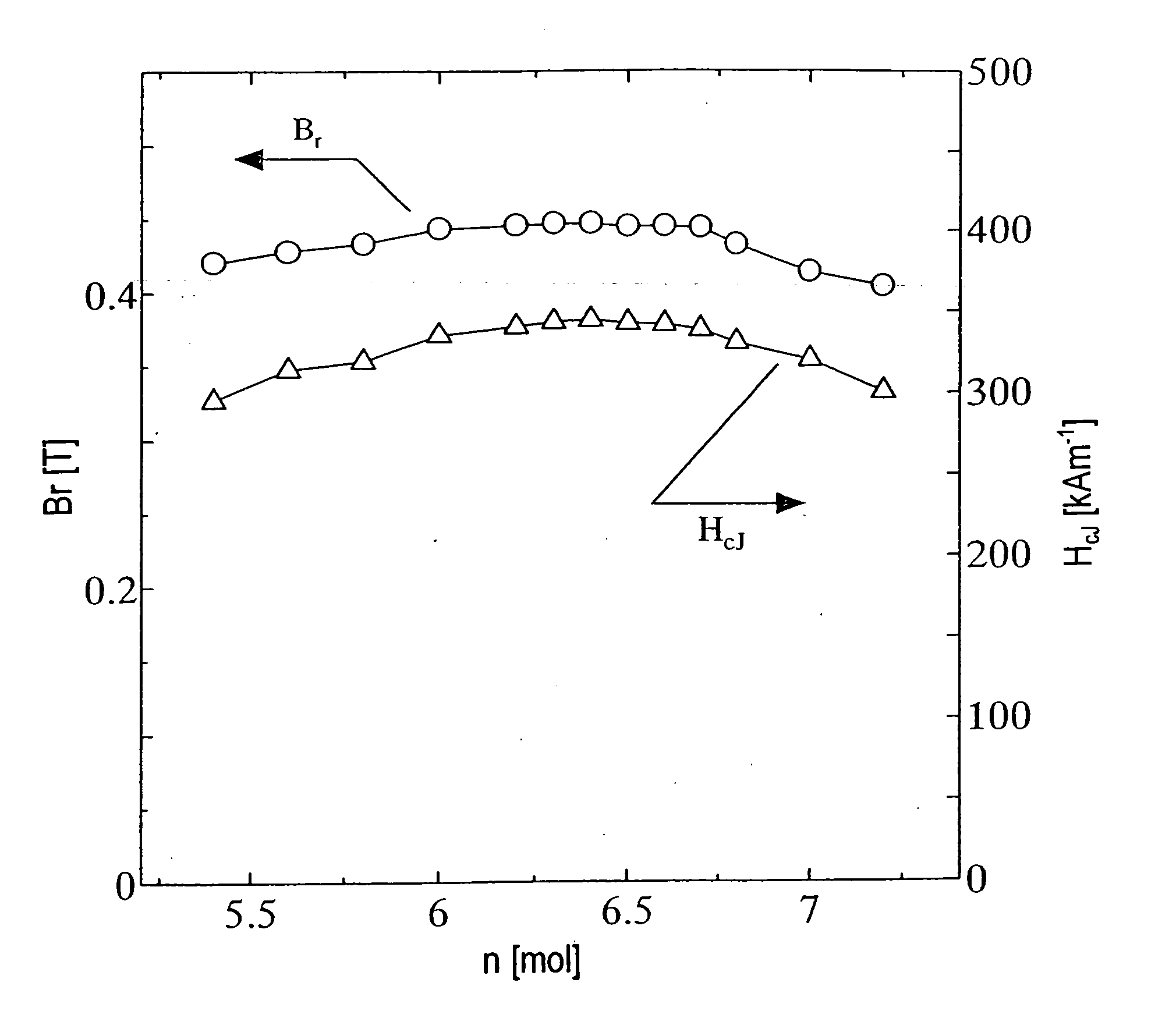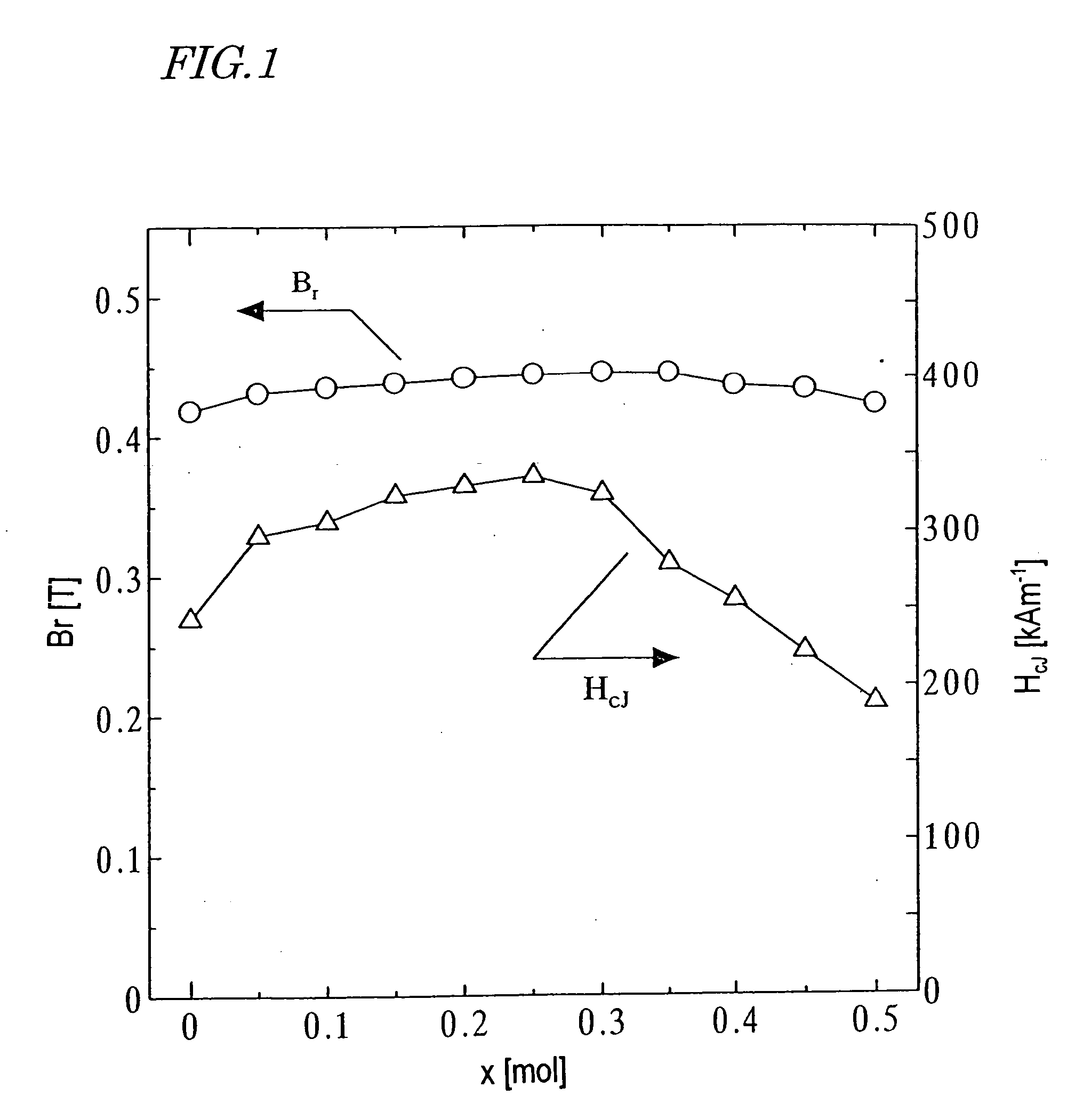Permanent magnet and method for preparation thereof
- Summary
- Abstract
- Description
- Claims
- Application Information
AI Technical Summary
Benefits of technology
Problems solved by technology
Method used
Image
Examples
example 2
[0147] First, as in the first example described above, a calcined body magnet powder with a composition (1-x)SrO.(x / 2)La.sub.2O.sub.3.n Fe.sub.2O.sub.3 was prepared so as to satisfy 0.ltoreq.x.ltoreq.0.5 and n=6.2.
[0148] This calcined body powder was analyzed by an X-ray diffraction method. As a result, in a range where x.ltoreq.0.35 was satisfied, an M-type ferrite single phase was identified. However, in a range where x.gtoreq.0.4 was satisfied, not only the M-phase but also an ortho-ferrite phase and a hematite phase were identifiable.
[0149] A CoO powder was added to this calcined body magnet powder such that the mole fraction y of the element M in the oxide of the element M to be added to one mole of the calcined body magnet powder satisfied 0.ltoreq.y.ltoreq.0.25 (i.e., y / x=0.5). Also, 0.7 wt % of CaCO.sub.3 powder and 0.4 wt % of SiO.sub.2 powder were further added thereto. After that, a sintered body was obtained as in the first example described above.
[0150] B.sub.r and H.su...
example 3
[0152] First, as in the first example described above, an M-type ferrite calcined body magnet powder with a composition (1-x)SrO.(x / 2)La.sub.2O.su-b.3 n Fe.sub.2O.sub.3 was prepared so as to satisfy x=0.2 and n=6.2.
[0153] A CoO powder was added to the M-type ferrite calcined body magnet powder during the fine pulverization process such that the mole fraction y of the element M in the oxide of the element M to be added to one mole of the calcined body magnet powder satisfied 0.ltoreq.y.ltoreq.0.22 (i.e., 0.ltoreq.y / x.ltoreq.1.1). After that, a sintered body was obtained as in the first example described above.
[0154] B.sub.r and H.sub.cJ of the resultant sintered magnet were measured. The results of measurement are shown in FIG. 2. As can be clearly seen from FIG. 2, H.sub.cJ increased in a range where 0.2.ltoreq.y / x.ltoreq.0.8 was satisfied and B.sub.r increased in a range where 0.2.ltoreq.y / x.ltoreq.1.0 was satisfied.
[0155] The magnetic properties were also tested as in the method d...
example 4
[0156] A calcined body magnet powder was prepared as in the first example described above except that respective materials were mixed together so as to satisfy x=0.2 and 5.4.ltoreq.n.ltoreq.7.2 in the composition (1-x)SrO.(x / 2)La.sub.2O.sub.3.n Fe.sub.2O.sub.3. Then, a sintered body was made of the calcined body magnet powder as in Sample No. 1 of the first example.
[0157] The resultant calcined body powder was analyzed by an X-ray diffraction method. As a result, in a range where 5.0<n.ltoreq.6.2 was satisfied, an M-type ferrite single phase was identified. However, in the other range, not only the M-phase but also an ortho-ferrite phase and a hematite phase were identifiable.
[0158] B.sub.r and H.sub.cJ of the resultant sintered magnet were measured. The results of measurement are shown in FIG. 3. As can be clearly seen from FIG. 3, B.sub.r and H.sub.cJ increased in a range where 6.0<n.ltoreq.6.7 was satisfied.
[0159] The magnetic properties were also tested as in the method describe...
PUM
| Property | Measurement | Unit |
|---|---|---|
| Angle | aaaaa | aaaaa |
| Angle | aaaaa | aaaaa |
| Angle | aaaaa | aaaaa |
Abstract
Description
Claims
Application Information
 Login to View More
Login to View More - R&D
- Intellectual Property
- Life Sciences
- Materials
- Tech Scout
- Unparalleled Data Quality
- Higher Quality Content
- 60% Fewer Hallucinations
Browse by: Latest US Patents, China's latest patents, Technical Efficacy Thesaurus, Application Domain, Technology Topic, Popular Technical Reports.
© 2025 PatSnap. All rights reserved.Legal|Privacy policy|Modern Slavery Act Transparency Statement|Sitemap|About US| Contact US: help@patsnap.com



